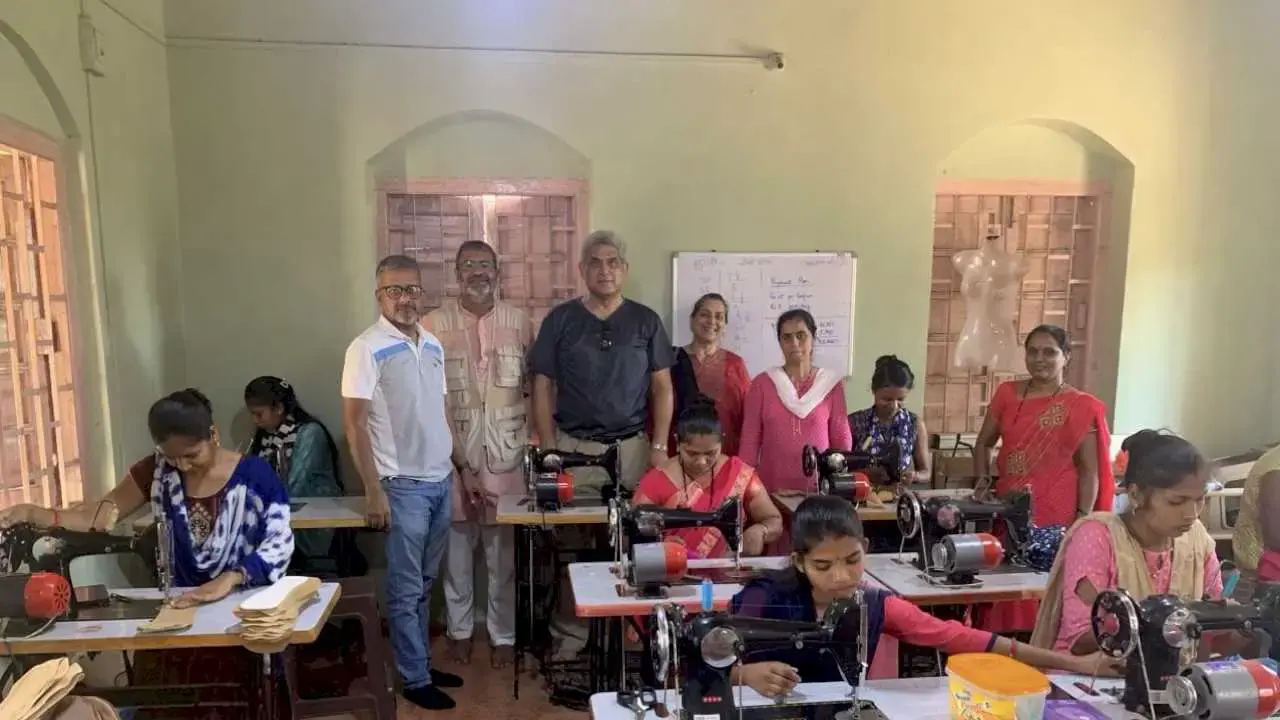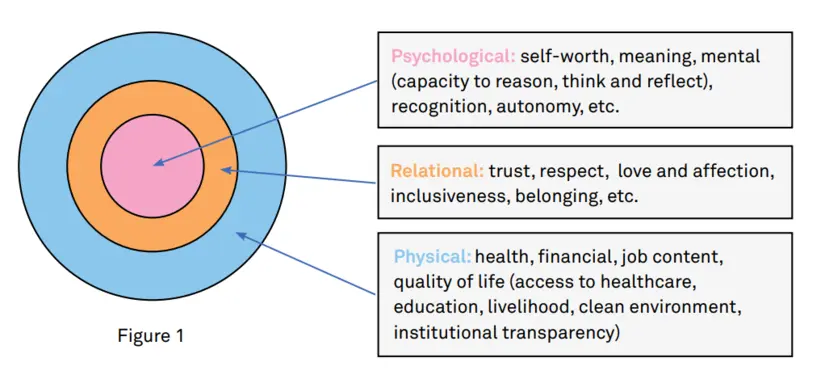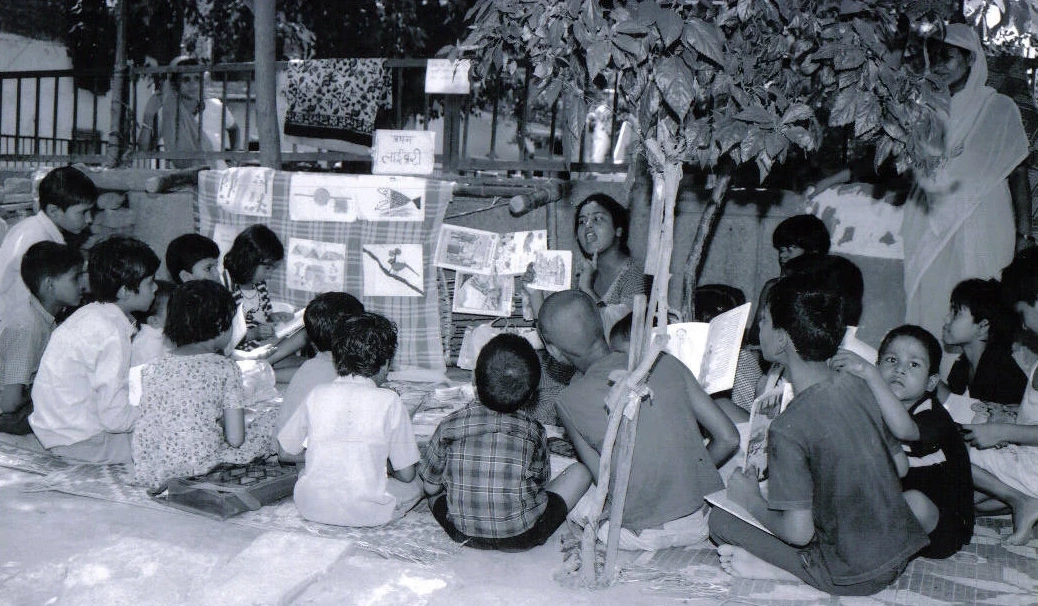Well-being at work
In his essay, explores a key aspect that is often overlooked in attempts to improve well-being at the workplace – the individual and collective interiority of team members.

What is well-being?
Well-being usually alludes to the state of positive experience perceived by an individual. This arises from extrinsic and intrinsic variables in three facets: physical, relational and psychological.
Figure 1 illustrates these variables.
The following explain the schematic concept. The variables in each circle are illustrative, not comprehensive. Each variable has a spectrum of perceived experience of an individual, with a range of, say -5 to +5.
Well-being is a state wherein an individual perceives each relevant variable in all the facets within a range of say, +3 to +5. This can be called the well-being zone. Physical variables are outside the scope of this article.
Inherent determinants of well-being
These are the two recognized categories with examples of constituent factors. The ones related to nature include innate characteristics such as proclivities and temperament.
Those related to nurture include life experiences based on gender, upbringing, socialization and culture. These result in beliefs, norms, values, triggered reactions, and in extreme cases, traumas.
Well-being at work
All organizations exist to fulfill their individual missions. Most organizations articulate their mission and values to achieve these. Values usually include those that are employee-centric, such as respect for others, trust and transparency.
However, the extent to which their leaders authentically live those values differentiates their organizations from others. It is this that creates leadership credibility. Employees then emulate their leaders. This creates a healthy work culture. This process is foundational to employee well-being.
Employee well-being also depends on intrinsic work-related variables in facets 1 and 2 in Figure 1, which an organization can influence. These include those related to the employees and their jobs, such as purpose, meaning, autonomy, value-add, attitude, etc.

This also relates to facets at the interface between employees and their team members. These include qualities like trust, openness, interdependence, collaboration, inclusivity and belonging, etc. An important set of factors relates to working in teams and team leaders, especially those pertaining to safety, trust, leader credibility, and fairness, etc.
If an employee is in the well-being zone, he would experience harmony with his job, team and leaders. Similarly, there would be harmony between the teams and their leaders. At a collective level, tangible benefits to an organization could include greater employee engagement, creativity and performance.
Even when organizations nurture well-being, they may not be able to influence some of its inherent determinants, such as an individual’s deeply embedded beliefs and trauma without professional counseling and therapy, which are not within the scope of this paper.
Well@Work Lab
Well@Work Lab is an eight-member team consisting of two sub-groups: four seniors, including me, with collective leadership experience of 125 years in MNCs in India, Africa, and the US. Subsequently, for many years, we have harnessed this experience in serving society in various roles. This includes contributing as a leading member in a major corporate foundation, and being a think-tank mentor to social impact organizations. Three other aspects unite us: our care for others’ well-being, our shared universal values, and being alumni of IIT Madras.
Our other, much younger, team members are full-time employees at commercial entities and NGOs. They share our values and interest in well-being. They keep us current by letting us know today’s workplace realities. Their dedication to Well@Work Lab is amply demonstrated by their diligent involvement in our three-year old journey through initial conceptualization, program design, and participation in our work, despite holding down full-time jobs.
We all share a deep yearning to do ‘something’ for helping organizations nurture wellbeing at work, given high levels of disengagement everywhere. After two years of diligent exploration, reflection and effort, we have started helping organizations do that.
We believe that our approach differs from others who may be similarly engaged in this worthy endeavor in several ways. We work with an organization only if we are convinced that their leaders will be part of the cultural change they wish to manifest. We believe that authentic change comes from going within, individually and collectively. It also involves being open to expressing one’s vulnerability, willingness and commitment to change. We help organizations implement their cultural prototype through a series of small behavioral shifts before scaling and hopefully sustaining.
The blind spot
The essence of a person’s well-being stems from the quality of his interiority along two dimensions. The first relates to the degree to which his ego takes center stage, driving his focus on achieving what he wants and the quality of his relations with others. The second refers to the degree to which he authentically lives by universal values such as integrity and compassion, especially in situations that he perceives to be counter to his physical or psychological well-being.
Interiority is everyone’s true ‘North Star’, which remains constant regardless of causes and conditions (factors). Interiority determines the quality of attributes like resilience and empathy, as well as ethics. Individual interiority also affects the collective interiority of teams.
A person has positive interiority if her ego is modulated – healthy enough for her own well-being, without getting in the way of her interactions with others. Someone who lives from a ‘mwe’ orientation instead of ‘me’. Their behavior is guided by universal values, regardless of the circumstances they face.
It should be noted that a person with low ego may not have positive interiority if it results in low self-esteem. On the other hand, they may have high positive interiority if their ego is low without affecting self-esteem and they genuinely put the well-being of others ahead of theirs own.
Persons universally respected for who they are as persons but not for their power or personal achievements have very high positive interiority. In an organization, the quality of the leader’s interiority greatly affects work culture and employee wellbeing.
An egotistic person will not admit mistakes and have little empathy for others. They would also place achievement of their own goals above shared goals. If they also compromise universal values when there’s a conflict involving their own self-interests, then they have negative interiority.
Many if not most variables in Figure 1 are dependent on various factors. For example, an employee’s well-being is dependent on his perceived (or real) fairness of the compensation, workload, manager, and so on.
Most organizations nurture well-being by addressing such factors. However, these wellmeaning efforts are unstable because they ignore interiority. This is their ‘blind spot’. It is a term used by Professor Otto Scharmer of MIT in the context of bringing about relatively lasting, significant changes in organizations, communities and societies. Figuratively, interiority would be at the center of Figure 1.
Moreover, most interventions in organizations use cognitive methods to create behavioral shifts. This approach almost always fails! Positive individual and collective interiority can be nurtured through non-cognitive experiences for change champions. This includes leaders to create and implement a prototype for the desired culture with individual well-being as the keystone.
Non-cognitive experiences expose an individual and his team to incorporate right brain qualities. These include intuition, emergent sense, and connectedness.
These processes help them get in touch somatically to sense the deep connection between thoughts and emotions, and the resultant physical sensations. This creates a shift from knowledge and logic to a deeper, felt knowing.
Cultivating positive interiority should be easier in non-profit organizations, including those in education, compared to their commercial counterparts for several reasons. This is because their focus is on serving beneficiaries, who in many cases are less privileged or underprivileged.
The nature of the benefits being provided is long-term. These include livelihood skills, healthcare access, and education. There is also direct interaction between most NGO employees and their beneficiaries. NGOs’ employees are able to see the impact of their work. These organizations are also smaller.
A good example would be an NGO focused on educating less privileged children. Here, the beneficiaries are young and vulnerable. The employees’ well-being and culture is very significant in determining the children’s adult lives.
In contrast, addressing interiority is likely to be a major challenge at commercial organizations. For example, they are primarily driven by the bottom-line. Consequently, failure to meet performance targets causes employees’ stress. Many employees with high egos thrive and get in the fast track. Their high egos propel them to achieve or exceed their targets.
Conclusion
Employee well-being is based on many variables. These variables in turn depend on the presence or absence of a host of factors.
Let us say an organization surveys the same set of well-being variables influenced by the provision (or lack thereof) of contributing factors. Then, no two individuals will have identical sense of well-being. However, two employees could be in a zone of well-being as described above. This would be a desirable state.
Achieving this is challenging for several reasons. Many factors are inherently unstable due to various causes and conditions. These include an organization’s leader, financial health, changes in the environment they operate in, socio-economic conditions, etc. Employee perceptions of their own well-being variables and contributing factors also affect their well-being. Moreover, these perceptions and expectations also change over time. As Heraclitus said, “The only constant in life is change.”
Many organizations sincerely attempt to nurture employee well-being in this dynamic environment by focusing on well-being factors. But such interventions must include cultivation of positive employee interiority through a non-cognitive approach, starting with the top leaders.
This requires authentic whole-being presence from everyone. It involves open expression of vulnerabilities, challenges and aspirations, individually and collectively, in a safe space. It also needs courage and commitment from everyone toward a shared purpose. This is what creates a desired culture by living underlying values.
Self-reflection is a core component of nonjudgmentally facing one’s interiority. It is not easy for individuals, and even harder for teams. Non-cognitive experiences are essential for authentic self-reflection and cultivating positive interiority. Well intentioned external facilitators who themselves embody positive interiority in working with the organization’s change champion leaders and employees can help them in this regard.




No approved comments yet. Be the first to comment!